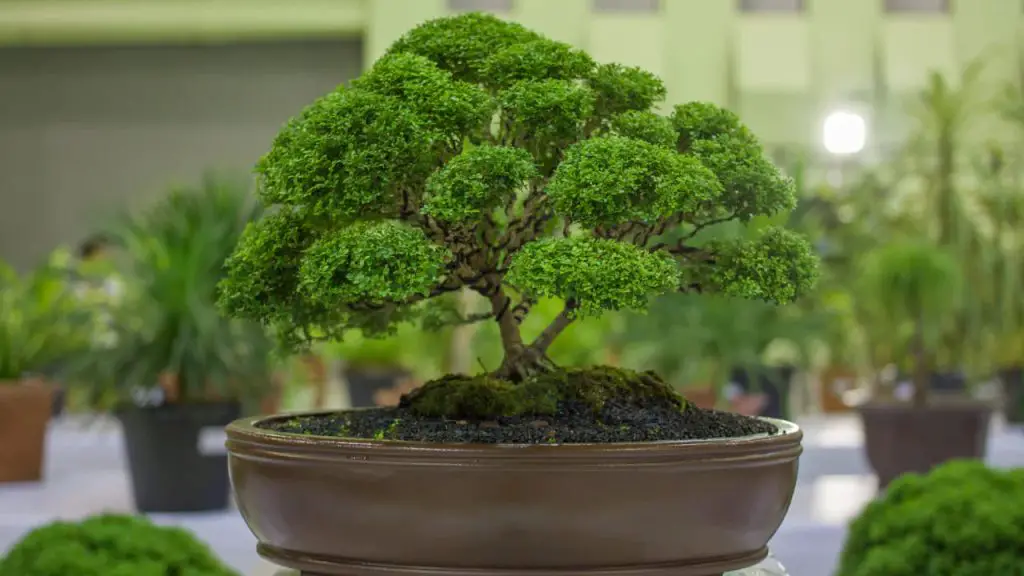Bonsai is an art form that originated in China and was later popularised in Japan. It has been around for over a thousand years and is an important part of Japanese culture and art.
In Japan, bonsai trees are usually grown outside, but people in areas with tough weather conditions are beginning to grow them inside.
This is becoming popular all over the world! Having a bonsai tree inside is a fantastic way to bring a little bit of nature into your home and make it more lively and attractive.
In this blog post, we will be discussed crucial aspects of caring for and maintaining bonsai trees. We’ll also discuss selecting the right bonsai for your home and recognizing and preventing pests and diseases that can threaten your plant’s healthy bonsai
So, let’s begin by taking the first step towards creating a beautiful and thriving bonsai by choosing the perfect one for your home.

1. Choosing the Right Bonsai for Your Home
1.1 Space
Bonsai trees come in various sizes, from small tabletop plants to larger trees that can grow up to several feet tall. Consider the space you have available in your home and choose a bonsai tree that fits comfortably within that space.
1.2 Style
Bonsai trees come in a wide range of styles and shapes, including formal upright, informal upright, slanting, and cascading. Choose a style that complements your personal taste and the overall décor of your home.
1.3 Species
There are many different species of bonsai trees to choose from, each with its own unique characteristics and requirements. Research different species and choose one that is well-suited to your level of expertise and the environment in your home.
These miniature trees not only add a touch of nature to your living space but also bring a sense of peace and tranquillity. Selecting the right bonsai tree for your home requires careful consideration of space, lighting, style, species, and care requirements.
With the right bonsai tree, you can enjoy the beauty and tranquillity of nature in your home for years to come.
2. How To Take Care Of A Bonsai?
Below we have discussed the upkeep and maintenance of bonsai trees.
2.1 Watering Techniques for Healthy Bonsai Growth
Bonsai trees need to be watered more frequently than regular trees because they’re grown in small pots with limited soil. To determine if your bonsai tree needs watering, feel the soil with your fingers – if it feels slightly dry, it’s time to water.
When watering your bonsai tree, use a watering can with a narrow spout to avoid damaging the leaves or soil. Water the soil slowly and evenly until water drains out from the bottom of the pot. Avoid overwatering, as this can cause root rot and damage to the tree.
It’s important that the amount of water your bonsai tree needs will depend on factors such as the species of the tree, the size of the pot, and the climate conditions in your area.
In addition to regular watering, it’s also important to pay attention to the humidity levels around your bonsai tree
Bonsai trees prefer high humidity, so you may want to consider placing a humidity tray near your tree or misting the leaves regularly. By following these watering techniques, you can help your bonsai tree grow and thrive for years to come.
2.2 The Best Soil for Your Bonsai
The ideal soil should be well-draining and provide good aeration for the roots. Bonsai trees have a limited amount of soil to grow in, so choose a soil mix that will provide the right balance of nutrients and moisture.
There are different types of soil mixes available, but a good basic mix consists of akadama, pumice, and lava rock. Akadama is a type of Japanese clay that provides good water retention and aeration, while pumice and lava rock add drainage and prevent compaction.
Avoid using regular garden soil or heavy potting soil, as they can retain too much water and suffocate the roots. Bonsai soil can be purchased at most garden centers or online, or you can create your own mix using the recommended components.
Remember to repot your bonsai every 2-3 years to refresh the soil and prevent root-bound conditions. The right soil mix will provide your bonsai with the necessary nutrients, drainage, and oxygen for healthy growth.
2.3 Light
These trees need a balance of light, not too much or too little. Most bonsai trees prefer bright, indirect sunlight, while some varieties may need more or less light.
It’s important to observe your bonsai tree and adjust the amount of light it receives accordingly. Too much direct sunlight can scorch the leaves and damage the tree, while too little light can lead to weak growth and poor health.
If you’re growing your bonsai indoors, place it near a window with filtered sunlight or use a grow light to supplement natural light. Outdoor bonsai trees can benefit from being placed in a partially shaded area or in a location with dappled sunlight.
Regularly monitoring the amount and quality of light your bonsai receives is key to ensuring its growth and health.
2.4 Tips for Pruning Your Bonsai Tree
To prune correctly, it’s essential to use the right tools, such as pruning shears, branch cutters, and concave cutters.
It’s best to prune during the growing season, which is typically in the spring or early summer, and avoid pruning during the winter when the tree is dormant. When pruning, look for branches that are crossing, rubbing, or growing in the wrong direction.
These branches can be pruned to maintain the desired shape of the tree. It’s also important to cut the branches at a 45-degree angle to promote healing and prevent the branch from dying.
However, it’s crucial not to over-prune as this can weaken the tree. Instead, prune gradually over time to ensure that the tree remains healthy and strong.
2.5 Fertilizing Your Bonsai for Optimal Growth
Choosing the appropriate fertilizer for your bonsai tree is vital, and it should contain a balanced combination of nitrogen, phosphorus, and potassium as these nutrients play a significant role in the tree’s general well-being and development.
Make sure to apply the fertilizer during the tree’s growing season, which is usually in the spring and summer when it’s actively growing. Avoid fertilizing during the dormant season, as the tree won’t be able to absorb the nutrients effectively.
To avoid damaging the roots, use the right amount of fertilizer according to the instructions on the package. Too much fertilizer can burn the roots and cause damage, while too little can lead to stunted growth.
Fertilize your bonsai tree regularly, about every two to four weeks during the growing season, to provide the necessary nutrients for healthy growth. By following these guidelines, you’ll be able to keep your bonsai tree thriving and looking beautiful.
2.6 Repotting Your Bonsai: When and How to Do it?
Repotting involves taking it out of its current pot and putting it in a new one with fresh soil. This helps refresh the soil and gives the tree more room for its roots to grow.
When should you repot your bonsai tree? It depends on how old and big it is. Generally, younger and smaller trees need to be repotted more often than older and larger ones. You should aim to repot your bonsai every two to five years.
When it’s time to repot your bonsai, you should gently remove it from its current pot, being careful not to damage the roots. You can then trim the roots a bit to encourage new growth and prevent them from becoming tangled.
Next, you’ll want to put the tree in a new pot with fresh soil. Make sure the pot is the right size for your tree – not too big, but not too small either. You can then water the tree and let it settle into its new home.
You should aim to do it every two to five years and be careful when removing the tree from its pot and trimming its roots. Finally, make sure to put it in a new pot with fresh soil that’s the right size for your tree.
3. Pests and Diseases to Watch Out for in Bonsai Trees
Bonsai trees, just like any other plant, are prone to pests and diseases. Here are some of the common ones to watch out for:
3.1 Spider mites
Spider mites are a common pest that can cause damage to bonsai trees. These small insects are hard to see with the naked eye, but their presence can be detected by the fine webbing they leave on the leaves.
Spider mites feed on the sap of the tree’s leaves, which can cause them to turn yellow or brown and fall off. If left untreated, spider mites can quickly multiply and cause significant damage to the tree.
Regularly inspecting your bonsai tree for signs of spider mites and treating them promptly can help prevent serious infestations.
3.2 Scale insects
They can attach themselves to the bark of the tree and feed on its sap, causing damage to the tree over time. These insects are often difficult to spot, as they look like small, raised bumps on the trunk and branches.
If left untreated, scale insects can weaken the tree and make it more susceptible to other pests and diseases then regularly inspect your bonsai tree for signs of scale insects and take action to control the infestation if you notice any symptoms.
3.3 Fungal diseases
Root rot, powdery mildew, and black spot are some examples of fungal diseases that can cause harm to the tree.
These diseases often occur due to overwatering, which can create a moist environment for the fungi to thrive in. Poor air circulation can also contribute to the growth of fungal diseases.
To prevent fungal diseases, then maintain proper watering and ensure that the tree has good ventilation. If you notice signs of a fungal disease, such as wilting leaves or white powder on the leaves, it’s important to take action immediately to prevent further spread.
3.4 Bacterial infections
Bacterial infections can be a serious threat to the health of your bonsai tree. These infections can cause a variety of symptoms, including leaf spots, stem cankers, and other damage.
Poor hygiene, contaminated tools, and infected soil can all contribute to the spread of bacterial infections in your bonsai tree.
To avoid bacterial infections in your bonsai tree, practice good hygiene by washing your hands and cleaning tools before working with the tree. Also, use sterile soil while repotting to prevent harmful bacteria from entering the tree’s environment.
Conclusion
In this blog post, we have explored caring and maintenance for bonsai trees including choosing the appropriate bonsai for your home and being aware of pests and diseases that may affect your plant.
We hope this information will be helpful to you. If you have any concerns, please feel free to leave a comment below.
FAQ’s
Can I keep my bonsai tree indoors all the time?
It depends on the species of your bonsai tree and the environmental conditions in your home. Some bonsai trees are well-suited to indoor environments, while others require outdoor conditions to thrive.
Be sure to research the specific needs of your bonsai tree before deciding where to place it.
How to take care of the bonsai tree in winter?
To care for your bonsai tree during winter, protect it from extreme temperatures by keeping it in a sheltered area. Adjust your watering routine as the soil may dry out more slowly. Reduce or stop fertilization and increase humidity to prevent stress on the tree.
Regularly monitor your tree for pests and diseases and treat any issues promptly. Avoid pruning during winter as it can stimulate new growth that is vulnerable to frost damage. Wait until spring to prune when the tree is actively growing.


